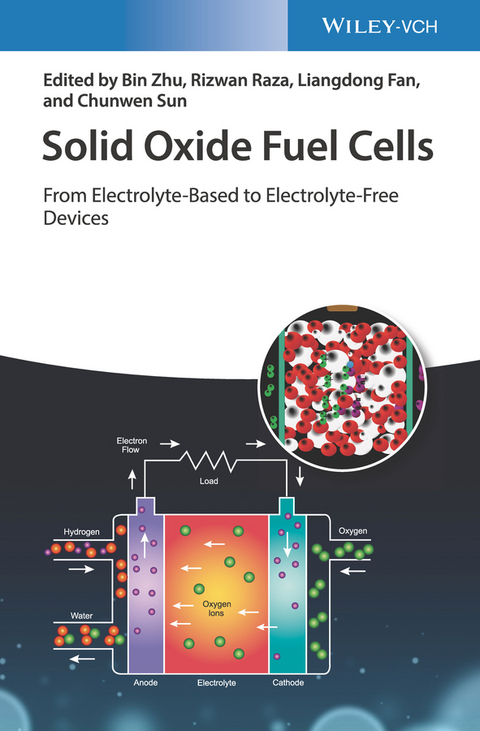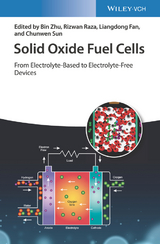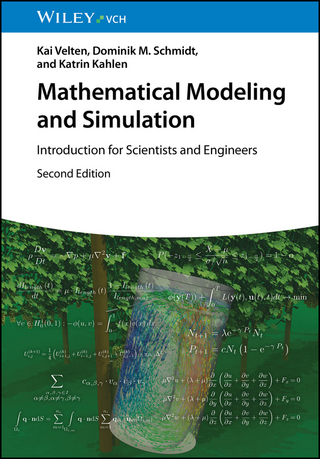Solid Oxide Fuel Cells
Wiley-VCH (Verlag)
978-3-527-34411-6 (ISBN)
Bin Zhu, PhD, is Professor in the Department of Energy Technology at the Royal Institute of Technology in Stockholm (KTH), Sweden. He has published more than 250 scientific papers in nano-composite ionic conductors and new semiconductor-ionic materials for advanced fuel cells. Rizwan Raza, PhD, is Assistant Professor in the Department of Physics in COMSATS Institute of Information Technology, Pakistan. He has published more than 100 scientific papers. Liangdong Fan, PhD, is Lecturer in the College of Chemistry and Environmental Engineering at Shenzhen University, China. His interests focus on novel nanocomposite functional materials for fuel cells and electro-catalysis. Chunwen Sun is a Professor at Beijing Institute of Nanoenergy and Nanosystems (BINN), Chinese Academy of Sciences (CAS). His research interests include energy storage and conversion, e.g., lithium/sodium-ion batteries, metal-air batteries, all-solid-state batteries, fuel cells and self-power systems.
PREFACE
PART I SOLID OXIDE FUEL CELL WITH IONIC CONDUCTING ELECTROLYTE
INTRODUCTION
An introduction to the principles of fuel cells
Materials and technologies
New electrolyte developments on LTSOFC
Beyond the state-of-the-art - the electrolyte-free fuel cell (EFFC)
Beyond the SOFC
SOLID-STATE ELECTROLYTES FOR SOFC
Introduction
Single-phase SOFC Electrolytes
Ion Conduction/transportation in electrolytes
Composite Electrolytes
NANOCOFC and material design principle
Concluding remarks
Acknowledgments
CATHODES FOR SOLID OXIDE FUEL CELL
Introduction
Overview of Cathode Reaction Mechanism
Development of Cathode Materials
Microstructure Optimization of Cathode Materials
Summary
ANODES FOR SOLID OXIDE FUEL CELL
Abstract
Introduction
Overview of Anode Reaction Mechanism
Development of Anode Materials
Development of kinetics, reaction mechanism and model of the anode
Summary and outlook
Acknowledgment
DESIGN AND DEVELOPMENT OF SOFC STACKS
Introduction
Change of cell output performance under D interface contact
Control design of transition from D to D interface contact and their quantitative contribution differentiation
Conclusions
References
PART II ELECTROLYTE-FREE FUEL CELLS: MATERIALS, TECHNOLOGIES AND WORKING PRINCIPLES
ELECTROLYTE-FREE SOFCS: MATERIALS, TECHNOLOGIES AND WORKING PRINCIPLES
Concept of the electrolyte-free fuel cell
SLFC using the ionic conductor based electrolyte
Developments on advanced SLFC
From SLFCs to semiconductor-ionic fuel cells (SIFCs)
The SLFC working principle
Remarks
Acknowledgments
References
CERIA FLUORITE ELECTROLYTES FROM IONIC TO MIXED ELECTRONIC AND IONIC MEMBRANES
Introduction
Doped ceria as the electrolyte for intermediate temperature SOFCs
Surface doping for low temperature SOFCs
Non-doped ceria for advanced low temperature SOFCs
References
CHARGE TRANSFER IN OXIDE SOLID FUEL CELLS
Oxygen diffusion in perovskite oxides
Proton diffusion in Perovskite-Type Oxides
Enhanced ion conductivity in oxide heterostructures
Summary
Acknowledgements
References
MATERIAL DEVELOPMENT II: NATURAL MATERIAL-BASED COMPOSITES FOR ELECTROLYTE LAYER-FREE FUEL CELLS
Introduction
Industrial-grade rare-earth for EFFCs
Natural hematite for EFFCs
Natural CuFe-oxide minerals for EFFCs
Bio-derived calcite for EFFC
References
CHARGE TRANSFER, TRANSPORTATION AND SIMULATION
Physical aspects
Electrochemical aspects
Ionic conduction enhancement in heterostructure composites
Charge transportation mechanism and coupling effects
Surface and interfacial state induced superionic conduction and transportation
Ionic transport number measurements
Determination of electron and ionic conductivities in EFFCs
EIS analysis
Semiconductor band effects on the ionic conduction, device performance
Simulations
Acknowledgments
References
ELECTROLYTE-FREE FUEL CELL: PRINCIPLES AND CROSSLINK RESEARCH
Introduction
Fundamental considerations of fuel cell semiconductor electrochemistry
Working principle of semiconductor-based fuel cells and crossing link sciences
Extending applications by coupling devices
Final Remarks
Acknowledgments
References
PART III FUEL CELLS: FROM TECHNOLOGY TO APPLICATIONS
SCALING UP MATERIALS AND TECHNOLOGY FOR SLFC
Single layer fuel cell (SLFC) engineering materials
Scaling up single layer fuel cell devices- tape casting & hot pressing
Scaling up single layer fuel cell devices - thermal spray coating technology
Short stack
Tests and evaluations
Durability testing
A case study for the cell degradation mechanism
Continuous efforts and future developments
Concluding remarks
Reference
PLANAR SOFC STACK DESIGN AND DEVELOPMENT
Internal manifold and external manifold
Interface between an interconnect plate and a single cell
Anti-oxidation coating of the interconnect plate
Design the flow field of interconnect plate and control the temperature distribution
The importance of sealing
The life of the stack, the chemical problems on the interface
Towards market products
Concluding remarks
Reference
ENERGY SYSTEM INTEGRATION AND FUTURE PERSPECTIVES
Solar Cell and Fuel Cell
Fuel cell-solar cell integration
Solar-Electrolysis-Fuel Cell Integration
Fuel cell-Biomass integration
The Fuel cell system modelling using biogas
The fuel cell system efficiency (heating and electrical)
Integrated new clean energy system
Summary
References
| Erscheinungsdatum | 27.12.2018 |
|---|---|
| Verlagsort | Weinheim |
| Sprache | englisch |
| Maße | 170 x 244 mm |
| Gewicht | 1104 g |
| Themenwelt | Naturwissenschaften ► Chemie |
| Technik ► Elektrotechnik / Energietechnik | |
| Technik ► Maschinenbau | |
| Schlagworte | Batterien u. Brennstoffzellen • Batteries & Fuel Cells • Brennstoffzelle • Chemie • Chemistry • Energie • Energy • Festoxidbrennstoffzelle • Hydrogen, Batteries & Fuel Cells • Materialien f. Energiesysteme • Materials for Energy Systems • Materials Science • Materialwissenschaften • Wasserstoff • Wasserstoff, Batterien u. Brennstoffzellen |
| ISBN-10 | 3-527-34411-X / 352734411X |
| ISBN-13 | 978-3-527-34411-6 / 9783527344116 |
| Zustand | Neuware |
| Informationen gemäß Produktsicherheitsverordnung (GPSR) | |
| Haben Sie eine Frage zum Produkt? |
aus dem Bereich




